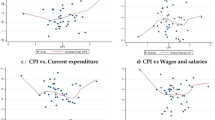Abstract
Corruption is thought to prevent poor countries from catching up with richer ones. We analyze one channel through which corruption hampers growth: public investment can be distorted in favor of specific types of spending for which rent-seeking is easier and better concealed. To study this distortion, we propose a dynamic model where households vote for the composition of public spending, subject to an incentive constraint reflecting individuals’ choice between productive activity and rent-seeking. In equilibrium, the structure of public investment is determined by the predatory technology and the distribution of political power. Among different regimes, the model shows a possible scenario of distortion without corruption in which there is no effective corruption but the possibility of corruption still distorts the allocation of public investment. We test the implications of the model on a set of countries using a two-stage least squares estimation. We find that developing countries with high predatory technology invest more in housing and physical capital in comparison with health and education. The reverse is true for developed countries.
Similar content being viewed by others
References
Acemoglu D (1995) Reward structures and the allocation of talent. Eur Econ Rev 39: 17–33
Acemoglu D, Verdier T (2000) The choice between market failures and corruption. Am Econ Rev 90(1): 194–211
Arrow K, Kurz M (1970) Public investment, the rate of return and optimal fiscal policy. The Johns Hopkins University Press, Baltimore
Banerjee AV (1997) A theory of misgovernance. Q J Econ 112(4): 1289–1332
Bardhan PK (2006) The economist’s approach to the problem of corruption. World Dev 34(2): 341–348
Barro R (1990) Government spending in a simple model of endogenous growth. J Polit Econ 98(5): S103–S125
Beck T, Levine R (2003) September. Legal institutions and financial development. Policy research working paper series 3136, The World Bank
Beck T, Clarke G, Groff A, Keefer P, Walsh P (2001) New tools in comparative political economy: the database of political institutions. World Bank Econ Rev 15(1): 165–176
Becker GS, Stigler GJ (1974) Law enforcement, malfeasance, and compensation of enforcers. J Legal Stud 3(1): 1–18
Bernheim D, Whinston M (1986) Menu auctions, resource allocation, and economic influence. Q J Econ 101(1): 1–31
Bockstette V, Chanda A, Putterman L (2002) States and markets: the advantage of an early start. J Econ Growth 7(4): 347–369
Boucekkine R (1995) An alternative methodology for solving non-linear forward-looking models. J Econ Dyn Control 19(4): 711–734
Coughlin P, Nitzan S (1981) Electoral outcomes with probabilistic voting and nash social welfare maxima. J Public Econ 15(1): 113–121
Cragg JG, Donald SG (1993) Testing identifiability and specification in instrumental variable models. Econom Theory 9(2): 222–240
de la Croix D, Delavallade C (2008) Democracy, Rule of Law, Corruption Incentives and Growth. CORE Discussion Paper, 2008/35
de la Croix D, Michel P (2002) A theory of economic growth: dynamics and policy in overlapping generations. Cambridge University Press, Cambridge
Delavallade C (2006) Corruption and distribution of public spending in developing countries. J Econ Finance 30(2): 222–239
Docquier F, Tarbalouti E (2001) Bribing votes: a new explanation to the “Inequality-Redistribution” puzzle in LDCs. Public Choice 108(3–4): 259–272
Gupta S, Sharan R, de Mello L (2000) February. Corruption and Military Spending. Imf working papers 00/23, International Monetary Fund
Gupta S, Davoodi H, Alonso-Terme R (2002) Does corruption affect income inequality and poverty?. Econ Governance 3(1): 23–45 (03)
Jacquemet N (2006) Micro-économie de la corruption. Revue Française d’Economie XX(4): 118–159
Juillard M (1996) A program for the resolution and simulation of dynamic models with forward variables through the use of a relaxation algorithm. Technical Report 9602, CEPREMAP, Paris
Kanczuk F (1998) The political economy of poverty trap. UCLA Ph.D. thesis
Kenny C (2007) June. Construction, corruption, and developing countries. Policy research working paper series 4271, The World Bank
La Porta R, Shleifer A, Vishny RW, Lopezde Silanes F (1998) Law and finance. J Polit Econ 106(6): 1113–1155
Leite C, Weidmann J (1999) Does mother nature corrupt—natural resources, corruption, and economic growth. Imf working papers 99/85, International Monetary Fund
Mariani F (2007) Migration as an antidote to rent-seeking?. J Dev Econ 84: 609–630
Mauro P (1997) Chapter The Effects of Corruption on Growth. In: Elliot K (ed) Investment and Government Expenditure of Corruption and the Global Economy, pp 83–108
Mauro P (1998) Corruption and the composition of government expenditure. J Public Econ 69(2): 263–279
McKenzie L (1986) Optimal economic growth, turnpike theorems and comparative dynamics. Chapter 26 of Handbook in Mathematical Economics, edited by Kenneth Arrow and Michael Intriligator, pp 1281–1355. North-Holland, Amsterdam
Persson T, Tabellini GE (2000) Political economics: explaining economic policy. MIT Press, Cambridge
Putterman L, Weil DN (2007) Post-1500 Population Flows and the Long Run Determinants of Economic Growth and Inequality. mimeo
Reinikka R, Svensson J (2004) The Power of Information: Evidence from Public Expenditure Tracking Surveys. Global Corruption Report 2004. Transparency International
Sargan J (1958) The estimation of economic relationships using instrumental variables. Econometrica 26(3): 393–415
Shleifer A, Vishny RW (1993) Corruption. Q J Econ 108(3): 599–617
Solow R (1956) A contribution to the theory of economic growth. Q J Econ 70(1): 65–94
Staiger D, Stock JH (1997) Instrumental variables regression with weak instruments. Econometrica 65(3): 557–586
Stock JH, Wright J (2000) GMM with weak identification. Econometrica 68(5): 1055–1096
Stock JH, Yogo M (2002) November. Testing for Weak Instruments in Linear IV Regression. Nber technical working papers 0284, National Bureau of Economic Research Inc
Stock JH, Wright JH, Yogo M (2002) A survey of weak instruments and weak identification in generalized method of moments. J Bus Econ Stat 20(4): 518–529
Tanzi V (1998) Corruption around the world: causes,consequences, scope, and cures. IMF Staff Pap 45(4): 1
Tanzi V, Davoodi H (1998) Roads to Nowhere: How Corruption in Public Investment Hurts Growth. Imf economic issues 12, International Monetary Fund
Author information
Authors and Affiliations
Corresponding author
Rights and permissions
About this article
Cite this article
de la Croix, D., Delavallade, C. Growth, public investment and corruption with failing institutions. Econ Gov 10, 187–219 (2009). https://doi.org/10.1007/s10101-008-0057-4
Accepted:
Published:
Issue Date:
DOI: https://doi.org/10.1007/s10101-008-0057-4




